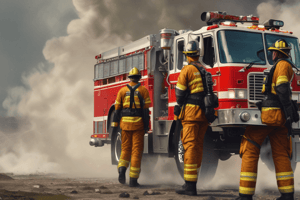Podcast
Questions and Answers
What is the primary purpose of the Emergency Response policy?
What is the primary purpose of the Emergency Response policy?
- To streamline fire response operations
- To manage financial records
- To ensure a safe and appropriate response to emergencies while maintaining the safety of department members and the public (correct)
- To enhance public relations
Which Massachusetts laws must operators of department vehicles adhere to during an emergency response?
Which Massachusetts laws must operators of department vehicles adhere to during an emergency response?
- G.L.c. 88, § 7
- G.L.c. 90, § 7
- G.L.c. 91, § 7
- G.L.c. 89, § 7 and G.L.c. 89, § 7B (correct)
Which of the following is NOT considered part of an emergency response?
Which of the following is NOT considered part of an emergency response?
- Emergency medical care
- Routine inspections (correct)
- Human rescue
- Hazardous materials release
What action should fire personnel take when initially dispatched to an emergency?
What action should fire personnel take when initially dispatched to an emergency?
Under what condition is it permissible for an emergency vehicle to exceed the speed limit during a response?
Under what condition is it permissible for an emergency vehicle to exceed the speed limit during a response?
Before an emergency vehicle operator drives through an intersection against traffic signals, what action must be taken?
Before an emergency vehicle operator drives through an intersection against traffic signals, what action must be taken?
When should emergency personnel respond using lights and sirens?
When should emergency personnel respond using lights and sirens?
Which action is NOT recommended when responding to an emergency call?
Which action is NOT recommended when responding to an emergency call?
What action should personnel take if they are not authorized to respond with emergency lights and siren?
What action should personnel take if they are not authorized to respond with emergency lights and siren?
What should emergency vehicle operators be vigilant about when responding to emergencies with multiple apparatus?
What should emergency vehicle operators be vigilant about when responding to emergencies with multiple apparatus?
What is required at all street intersections for emergency vehicle operators?
What is required at all street intersections for emergency vehicle operators?
If the emergency warning equipment on a vehicle fails, what must be done?
If the emergency warning equipment on a vehicle fails, what must be done?
What must be ensured when more than one emergency vehicle is responding to the same incident?
What must be ensured when more than one emergency vehicle is responding to the same incident?
What is the responsibility of emergency vehicle operators when directed by a supervisor to discontinue the emergency response?
What is the responsibility of emergency vehicle operators when directed by a supervisor to discontinue the emergency response?
What procedure should be followed if emergency vehicle operators decide to stop using red lights and siren due to unsafe conditions?
What procedure should be followed if emergency vehicle operators decide to stop using red lights and siren due to unsafe conditions?
What is a key consideration for emergency vehicle operators while en route to an emergency response?
What is a key consideration for emergency vehicle operators while en route to an emergency response?
What should personnel do if they are unsure about accounting for traffic in approaching lanes at an intersection?
What should personnel do if they are unsure about accounting for traffic in approaching lanes at an intersection?
What is the policy regarding driving through an intersection with a red light during an emergency response?
What is the policy regarding driving through an intersection with a red light during an emergency response?
Flashcards are hidden until you start studying
Study Notes
Emergency Response Policy Overview
- Primary goal: Ensure safe and effective responses to emergencies while protecting department members and the public.
Legal Compliance
- Operators of emergency vehicles must adhere to Massachusetts G.L.c. 89, § 7 and G.L.c. 89, § 7B during emergency responses.
Definition of Emergency Response
- Emergency response includes medical care, human rescue, and hazardous materials release, but excludes routine inspections.
Response Protocols
- Fire personnel should proceed immediately to emergencies, activating emergency lights and sirens as necessary.
- Emergency vehicles can exceed speed limits if the operator ensures safety and due regard for persons and property.
Intersection Safety
- Emergency vehicle operators must come to a full stop at intersections before proceeding against traffic signs, ensuring caution and safety.
Emergency Lights and Sirens
- Only use emergency lights and sirens when dispatched to an emergency or when circumstances indicate the need.
- If unauthorized to use emergency lights and sirens, personnel must follow all traffic laws.
Situational Awareness
- Operators must be cautious and aware of other emergency vehicles when more than one apparatus is responding.
- Reduce speed at all street intersections, stopping completely at blind intersections or where traffic controls apply.
Discretion in Emergency Responses
- Both the emergency vehicle operator and the Lieutenant/Senior FF can decide to continue or discontinue responses based on roadway conditions and safety.
Equipment Failure Protocol
- If emergency warning equipment fails, terminate the response and notify Dispatch for reassignment of apparatus.
Traffic Management
- Personnel should stop and assess safety before proceeding if they cannot see approaching traffic at intersections.
- If emergency lights and sirens are discontinued due to unsafe conditions, Dispatch must be notified.
Key Considerations for Operators
- The foremost priority for emergency vehicle operators is the safety of all persons and property during responses.
- Coordination among multiple responding emergency vehicles is crucial for efficient incident management.
Studying That Suits You
Use AI to generate personalized quizzes and flashcards to suit your learning preferences.




